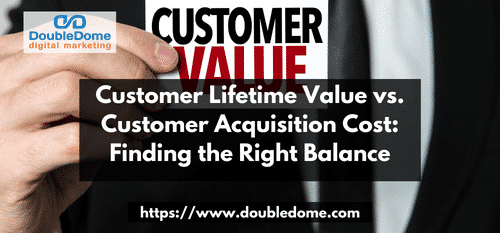Businesses are always looking for ways to bring in more money and make more money. Customer lifetime value (CLV) and customer acquisition cost (CAC) are two important metrics that they often use to measure success. CLV is the amount of money a customer brings in over the course of their relationship with a business. CAC is the amount of money it costs to get a new customer. Businesses need to find the right balance between these two metrics if they want to be successful in the long run. In this blog post, we’ll talk about how important CLV and CAC are, how to figure out their values, and how to find the right balance between the two.

Why Customer Lifetime Value Is So Important
Customer lifetime value is a metric that shows how much money a customer is likely to bring in over the course of their relationship with a business. This includes not only the first purchase, but also any repeat purchases, upsells, and referrals that the customer makes. CLV is important because of the following:
Helps businesses figure out how much their customers are worth.
By figuring out CLV, businesses can figure out how much each customer is really worth and make better decisions about how to use their resources to get and keep customers.
It helps businesses figure out who their best customers are.
By looking at CLV, businesses can figure out who their most valuable customers are and come up with ways to keep them as customers. This can be done by making personalized offers and incentives, making the customer experience better, and putting money into loyalty programs, among other things.
Helps businesses figure out how well their marketing and efforts to keep customers help them.
By keeping an eye on how CLV changes over time, businesses can figure out how well their marketing and efforts to keep customers can work. If CLV goes up, it means that customers are becoming more valuable to the business. If CLV goes down, it could mean that customers are becoming less loyal or switching to competitors.
Why Customer Acquisition Cost Is Important
The cost of getting a new customer is called the customer acquisition cost. This includes the costs of marketing, advertising, and sales that are needed to get a new customer to buy something for the first time. CAC is important because of the following:
Helps businesses figure out how much it costs to get new customers.
By figuring out CAC, businesses can figure out how much it really costs to get new customers and make better decisions about how to spend their money to get and keep customers.
Helps companies find the most cost-effective ways to get customers.
By looking at CAC by acquisition channel, companies can figure out which channels are the most cost-effective and put their resources there. This can include things like optimizing paid search campaigns, making email marketing campaigns work better, and putting money into content marketing.
Helps businesses figure out how well their sales and marketing are working.
By keeping track of how CAC changes over time, businesses can figure out how well their marketing and sales work. If CAC is going down, it means that the business is getting better at getting new customers. On the other hand, if CAC is going up, it could mean that the business is getting worse at getting new customers.
Calculating Customer Lifetime Value
Customer lifetime value can be hard to figure out because businesses have to make assumptions about how customers will act in the future. But there are a number of common ways for businesses to figure out CLV:
Average Order Value (AOV) Method
The AOV method figures out CLV by multiplying the average order value by the number of repeat purchases and the average customer life span. For example, if the average order is $50, the customer buys three times a year, and the average customer stays with a business for three years, the CLV is $450 ($50 times three purchases per year times three years).
Method for Customer Retention Rate (CRR)
The CRR method figures out CLV by multiplying the average order value by the rate of keeping customers and the average time a customer stays with a business. For example, if the average order value is $50, the customer retention rate is 80%, and the average customer life span is 3 years, the CLV would be $120 ($50 x 0.8 retention rate x 3 years).
Method for Cohort Analysis
The cohort analysis method is more complicated because it looks at how groups of customers behave over time. This method takes changes in customer behavior, such as changes in how often they buy and how much they buy, into account and can give more accurate estimates of CLV.
Figuring out how much it costs to get a customer
To figure out how much it costs to get a new customer, you have to add up all of the costs, such as marketing and advertising costs, sales commissions, and any other costs related to the sales process. This is how to figure out CAC:
CAC = (Total marketing and sales costs) / (Number of new customers gained)
For example, if a business spends $10,000 on marketing and sales in a month and gets 100 new customers, the CAC would be $100 ($10,000 divided by 100 new customers).
Getting the right mix of CLV and CAC
Businesses need to find the right balance between CLV and CAC if they want to do well in the long run. If a business focuses too much on getting new customers and not enough on keeping the ones it already has, it may spend more money getting new customers than it makes in sales. On the other hand, if a business focuses too much on keeping the customers it already has and not enough on getting new ones, it might miss out on growth opportunities.
Businesses can find the right balance between CLV and CAC in a few different ways:
CLV can be raised by keeping customers and selling them more.
Focusing on customer retention and upselling is one of the best ways to raise CLV. Businesses can get customers to buy from them again and again and increase the value of their orders over time by giving them good customer service, giving them personalized recommendations and deals, and making their experience as smooth as possible.
CAC will go down if marketing and advertising are more focused.
Using targeted marketing and advertising is another way to find the right balance between CLV and CAC. Businesses can cut their marketing and advertising costs while still getting new customers if they focus on the most cost-effective customer acquisition channels and make sure their marketing campaigns reach the right people.
Use data to improve sales and marketing efforts
Lastly, businesses can use data to find the right balance between CLV and CAC and improve their marketing and sales efforts. By looking at how customers act, how well their marketing campaigns work, and who their most valuable customers are, businesses can make better decisions about how to use their resources and make the most money.
Conclusion
Customer lifetime value and customer acquisition cost are two important metrics that businesses use to measure their success and make strategic decisions. By knowing how important CLV and CAC are, calculating them correctly, and finding the right balance between them, businesses can increase their profits, keep valuable customers, and grow their customer base over time. Businesses can find the right balance between CLV and CAC and have long-term success if they focus on keeping customers, improve customer acquisition channels, and use data to help them make decisions.








